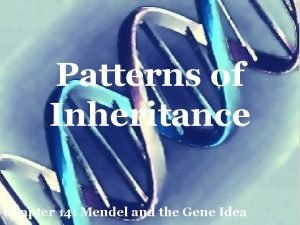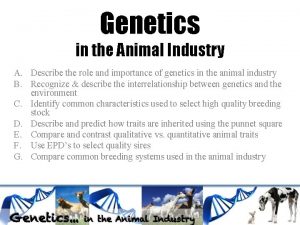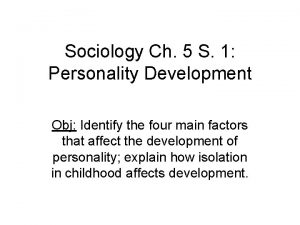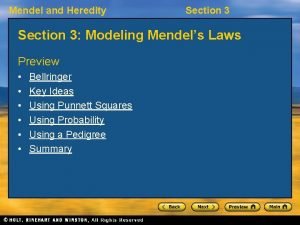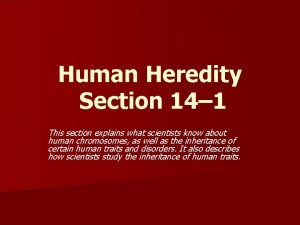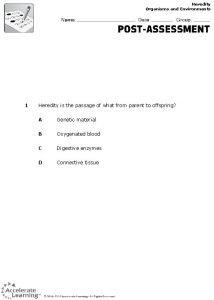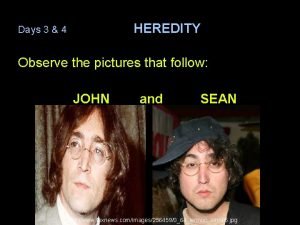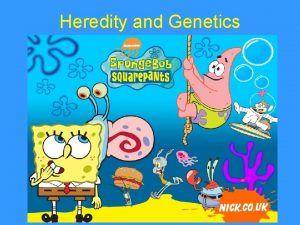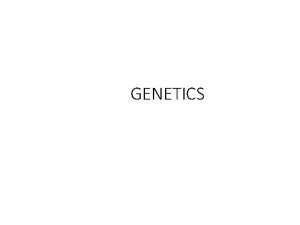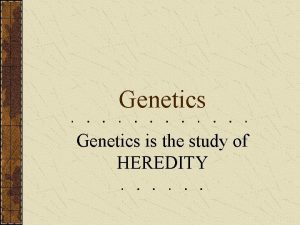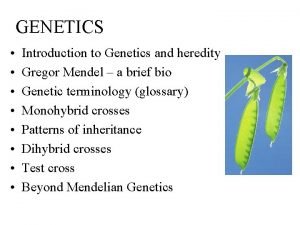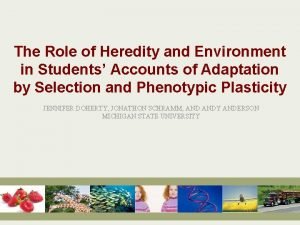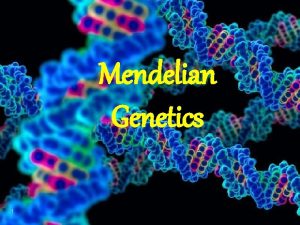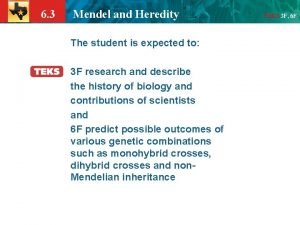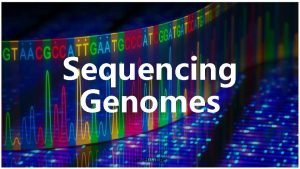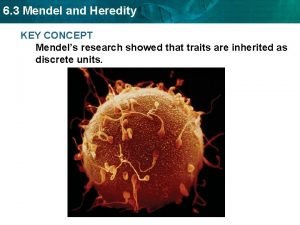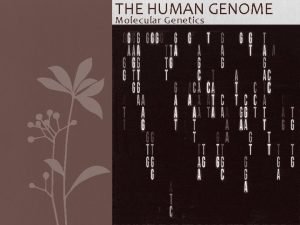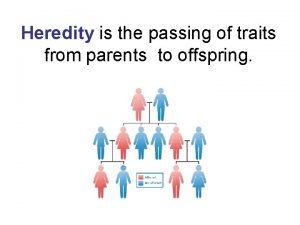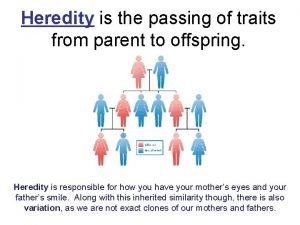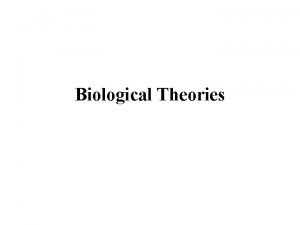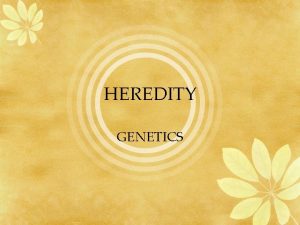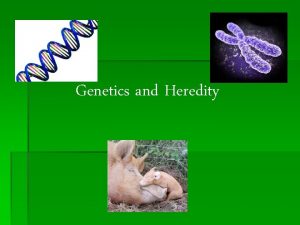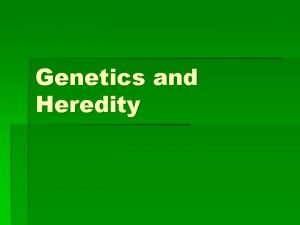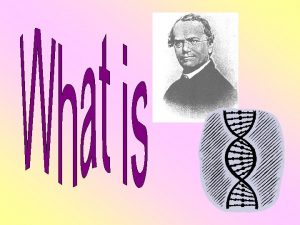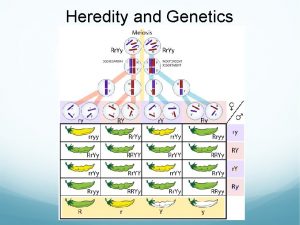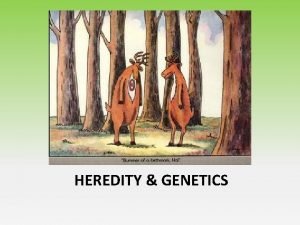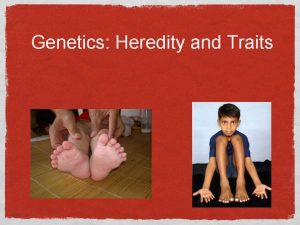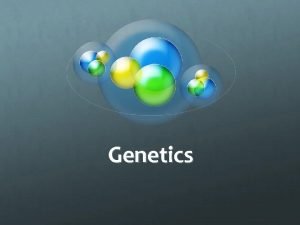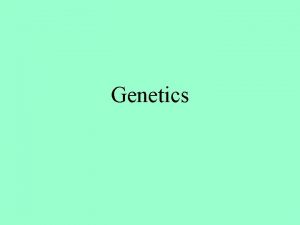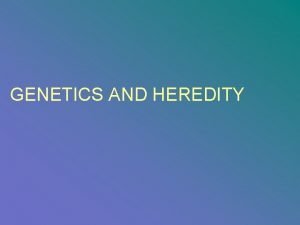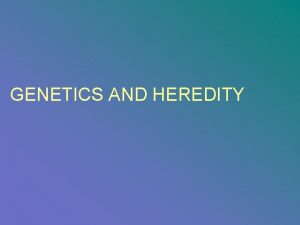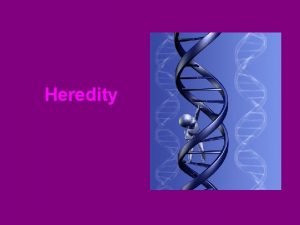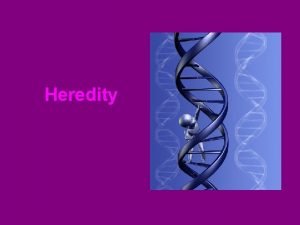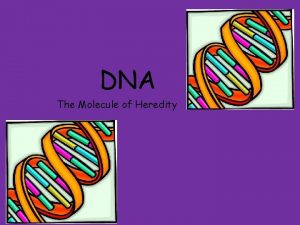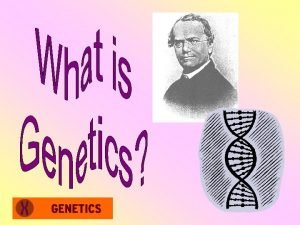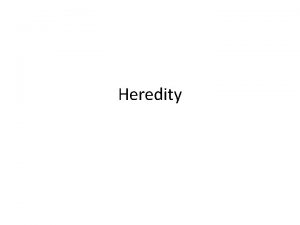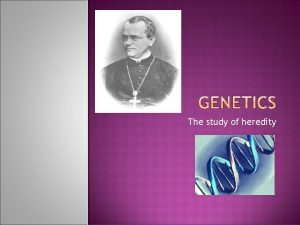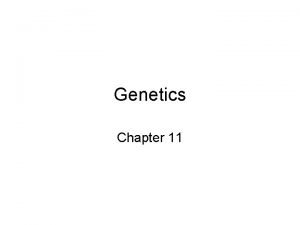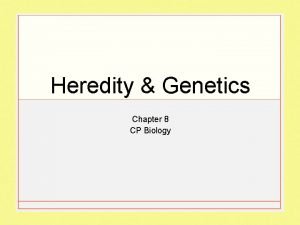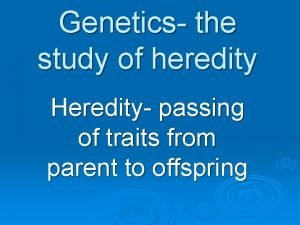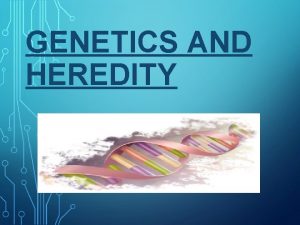GENETICS Chapter 5 Heredity The passing of traits

































- Slides: 33

GENETICS Chapter 5

Heredity- The passing of traits from parent to offspring • Genes on chromosomes control the traits that show up in an organism • The different forms of a trait that a gene may have are alleles • During meiosis a pair of chromosomes separates and the allelles move into separate SEX CELLS. • Each sex cell now contains ONE allele for each trait Genetics- The study of how traits are inherited

Name some traits you have inherited from your mom, Dad, Grandma, Grandpa…etc

GREGOR MENDEL The father of genetics Mendel was the first to use mathematical probability to explain heredity and to trace one trait for several generations.

Mendel’s Experimental Methods • Pea plants were ideal for genetic studies because they reproduce quickly, they have easily observed traits; and the experimenter can control which pairs of plants reproduce.

Mendel controlled which plants pollinated other plants. • When true breeding plant self-pollinates, it always produces offspring with traits that match the parent. • By cross-pollinating plants himself. Mendel was able to select which plants pollinated other plants. • With each cross pollination Mendel did, he recorded the traits that appeared in the offspring.

Mendel’s results • Mendel crosses between true breeding plants with purple flowers produced plants with only purple flowers. Crosses between true breeding plants with white flowers produced plants with only white flowers. • Crosses between true breeding plants with purple flowers and true breeding plants with white flowers produced plants with only purple flowers. • The first generation purple flowering plants are called hybrid plants. • When Mendel cross-pollinated two hybrid plants, the trait that had disappeared in the first generation always reappeared in the second generation.


Mendel’s Conclusions • After analyzing the results of his experiments, Mendel concluded that two factors control each trait. • Mendel also proposed that, when organisms reproduce , each reproductive cell- sperm or egg- contributes one factor for each trait. • A genetic factor that blocks another genetic factor is DOMINANT. • A Genetic factor that is blocked by the presence of a dominant factor is called RECESSIVE.

Dominant Traits

Hybrid- receive different genetic information for a trait from each parent DOMINANT ALLELE Covers up or dominates the other trait RECESSIVE ALLELE The trait seems to disappear

What controls traits? • Inside each cell is a nucleus that contains threadlike structures called chromosomes. • Mendel’s factors are parts of chromosomes, and each cell in offspring contain chromosomes from each parent. • A gene is a section on a chromosome that has genetic information for one trait. • The different forms of a gene are called alleles.

Genotype- the genetic make-up of an organism Homozygous- an organism with two alleles for one trait that are the same (TT) Heterozygous- an organism with two alleles for one trait that are different (Tt) Phenotype- The way an organism looks or behaves as a result of its genotype

PUNNETT SQUARE- can help you predict what an offspring will look like • Uppercase letters stand for dominant alleles • Lowercase letters stand for recessive alleles



How do heredity and genetics explain why people are different?

Incomplete dominance • Neither allele for a trait is dominant • The phenotype produced is intermediate between the two homozygous parents

Multiple alleles • More then two alleles that control a trait are called multiple alleles • Traits controlled by multiple alleles produce more then three phenotypes

Polygenic inheritance • A group of gene pairs acts together to produce a trait, which creates more variety in phenotypes • Many human traits are controlled by polygenic inheritance, such as hair and eye color

Polygenic traits

MUTATIONS-genes that are altered or copied incorrectly • A mutation can be harmful, beneficial, or have no effect • chromosome disorders- caused by more or fewer chromosomes then normal • Down’s syndrome- caused by an extra copy of chromosome 21

Examples of mutations

Recessive genetic disorders • Both parents have a recessive allele responsible for the disorder and pass it on to their child • Because the parents are heterozygous, they do not show any symptoms • Cystic fibrosis is a homozygous recessive disorder


SEX DETERMINATION • Chromosomes that determine the sex of an organism are XX in females and XY in males • Females produce eggs with an X chromosome only, males produce sperm with either an X or a Y

Sex Linked Disorders • An allele inherited on an X or Y chromosome is a sex-linked gene. • Color blindness is a sex linked disorder caused by a recessive allele on the X chromosome. • A Pedigree follows a trait through generations of a family

How does environment affect your hereditary traits?

ADVANCES IN GENETICS • Genetic engineering- changing the arrangement of DNA that makes up a gene • Recombinant DNA-insertion of a useful segment of DNA into bacterium - insulin is made by genetically engineered organisms Gene therapy- a normal allele is placed into the virus which delivers the normal allele when it effects its target cell. Can be used to control cystic fibrosis or other genetic disorders. Genetically engineered plants- created by inserting the genes that produce the desired traits in one plant into another.

Explain what is happening in these cartoons.


Genetically engineered plants and food

Recombinant DNA
 Chapter 17 lesson 2 heredity and genetics
Chapter 17 lesson 2 heredity and genetics Intermediate inheritance
Intermediate inheritance Chapter 11 human heredity section 11-3
Chapter 11 human heredity section 11-3 Chapter 11 complex inheritance and human heredity test
Chapter 11 complex inheritance and human heredity test Chapter 14 human heredity
Chapter 14 human heredity Chapter 14 patterns of heredity
Chapter 14 patterns of heredity Quantitative traits
Quantitative traits Qualitative traits vs quantitative traits
Qualitative traits vs quantitative traits Qualitative traits vs quantitative traits
Qualitative traits vs quantitative traits Passing love chapter 3
Passing love chapter 3 Genetic vocabulary worksheet answer key
Genetic vocabulary worksheet answer key An unchanging, biologically inherited behavior pattern.
An unchanging, biologically inherited behavior pattern. Heredity concept map
Heredity concept map Section 3 mendel and heredity
Section 3 mendel and heredity Section 14-1 human heredity
Section 14-1 human heredity Heredity is best described as the -
Heredity is best described as the - Pictures of heredity
Pictures of heredity Heredity examples
Heredity examples Heredity
Heredity ____________ is the study of heredity.
____________ is the study of heredity. Mendel
Mendel Unit 7 cell division and heredity
Unit 7 cell division and heredity Importance of heredity and environment in education
Importance of heredity and environment in education Section 3 mendel and heredity
Section 3 mendel and heredity Heredity terminology
Heredity terminology What are the basic units of heredity
What are the basic units of heredity Mendel 9 3 3 1
Mendel 9 3 3 1 Sanger sequencing
Sanger sequencing Section 3 mendel and heredity
Section 3 mendel and heredity Section 3 mendel and heredity
Section 3 mendel and heredity Heredity
Heredity Heredity
Heredity What is regeneration
What is regeneration Heredity and crime
Heredity and crime





